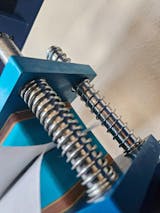Everybody's talking about it.
Many have tried it.
But just as many don't really know what it is.
Rosin.
It has taken the cannabis industry by storm.
And it's easy to see why.
In today's world, we value products that are clean and pure. No contaminants and a better high is a recipe for success.
The rosin industry has exploded as a result. Even better: we can all make our own rosin at home. Check out the numbers in that article...it's insanely profitable!
Let's take a closer look at this wonderful extract and see exactly why many are hailing it as the ONLY way to consume cannabis.
What Is Rosin?
In its standard meaning, rosin is a solid form of resin obtained from pines and other plants using heat. Fresh resin is heated to vaporize terpenes and form a semi-transparent compound that ranges in color from yellow to black. It is commonly used on violin bows.
When it comes to marijuana, the rosin process takes a marijuana product like flower, shake, kief or hash and adds heat and high pressure to produce a solvent-less hash oil (SHO). It is a quick and simple process that yields a golden sap with extremely high potency. Even better, no solvents are used in production.
Why Is Rosin So Popular?
Solventless hash oil has taken the industry by storm and there are 3 main reasons for that:
- Potency
- Purity
- Ease Of Production
Let's take a look at each in turn.
Potency of Rosin
The potency of SHO can vary a lot, depending on the material and the pressure, temperature and time used to process it. At its best, SHO has the potential to achieve a potency above 90% (flower can reach at most 30%). That makes rosin similar to other concentrates. The big difference is purity.
Purity of SHO (Vs. BHO And Other Concentrates)
Solventless hash oil is extracted using heat and pressure only. No solvents are used whatsoever (as the word 'solventless' might suggest). That is what distinguishes rosin from other concentrates.
The one SHO gets compared to most often is butane hash oil (BHO). BHO uses butane to remove the cannabinoids from the terpenes. While the butane is purged from the oil, some residual solvent usually remains.
Moreover, the BHO extraction process allows you to cover up for low-quality starting material. The chemicals used make it possible to disguise moldy flower, cheap trim or some other undesirable material.
The process of extracting SHO does not give you this liberty, meaning you must use a high-quality input material. The rosin you end up with is a direct reflection of the starting material, because you can not change the chemical makeup. The integrity of the plant is maintained.
Ease Of Production
Producing a concentrate using a hydrocarbon solvent like butane takes at least 24 hours, because the solvent must be purged before the concentrate can be consumed.
Producing a batch of SHO takes mere seconds. If you take into account the time needed to heat up the plates, it still takes under 10 minutes. It can be produced using items most of us have at home. The entire process of extracting your own is described in this article.
The one big advantage of BHO is that it is much easier to produce in bulk. While modern presses have made it possible to produce larger quantities commercially and even at home, SHO will never attain the level of bulk production possible with BHO. Extracting SHO is simply a more labor-intensive process.
Despite being more labor intensive, the extraction of SHO is much more straightforward than BHO and that is why so many people have gotten themselves a hair-straightener and tried making their own.
But what if you don't want to make your own? You're in luck. More and more dispensaries now stock it. You just want to make sure you're getting a quality product for your money.
What To Look For When Buying Rosin
Most products being sold in stores are good quality, but there are exceptions. The good news is: since the quality of starting material is directly reflected in the final output, it is easy to identify subpar SHO. Here's what to look for:
Color
Good oil has a clean, light amber or tan color. It is consistent in color and shatter and sap forms should be translucent.
A green color indicates that plant matter (chlorophyll) is present. Plant matter can also look like small specks or hairs.
A dark color means older starting material, but that doesn't necessarily mean it is poor quality.
Smell
Since the output directly reflects the input, a quality product smells like the flower it came from. If it has no smell, it's no good. Likewise, you want to avoid any with a hay-like smell.
Taste
Similar to smell, a quality extract will reflect the flavor of the input material. That is why it is so important to use high-quality material when extracting rosin. It is the main factor impacting quality.
What Next?
Isn't it obvious?
Now that you know what rosin is, I imagine you want nothing more than to try some. That's a great idea. If you haven't tried it yet, you should definitely go out and get yourself some.
You now know what to look for, so you should be able to distinguish good rosin from bad. If you live in a state where it is legal, and reputable dispensary will help you out, so even if you're not sure what you're doing, you'll get quality SHO.
If you live in a state where it is not legal, getting your hands on quality rosin is going to be much more difficult. Your best bet is probably to make it yourself (hypothetically, of course—we certainly don't advocate you break any laws).
Those living in legal states might think about making their own as well. For you, it is easy to get your hands on quality input material and a decent rosin press. NugSmasher presses (reviewed here) are the best value, but you could even use a hair straightener. Most people do when they first get started.
The extraction process is surprisingly easy. Here's how to do it. That article takes you through all the steps and even includes information for those using the hair straightener method. Follow the steps and you'll have your own freshly presses rosin in no time.
Now it's your turn: have you tried rosin before? What did you think? Have you ever tried extracting your own? How did it go?
Let us know in the comments below!
Disclaimer: Some things discussed in this guide may be illegal in your location. We do not encourage the violation of any laws. If anything above is not legal in your area, then please understand it is for entertainment purposes only (specifically, for the entertainment of those who live somewhere with better laws…).









Leave a comment